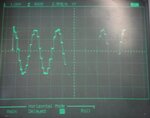SharpWeapon
Member level 5
Hi,
I was wondering how we can read an XY plot regarding scaling.
For instance if I drive X by a sawtooth (period of Ts and slope of A volts/sec) and Y by a sin wave of(1 Hz, 1Vpp, B volts/div), I will of course will get a sin wave in XY plot. But how can I read the division(both time and volt) scaling in my XY plotted sin wave. In other words, what is the scaling of the X and Y-axis?
Best,
I was wondering how we can read an XY plot regarding scaling.
For instance if I drive X by a sawtooth (period of Ts and slope of A volts/sec) and Y by a sin wave of(1 Hz, 1Vpp, B volts/div), I will of course will get a sin wave in XY plot. But how can I read the division(both time and volt) scaling in my XY plotted sin wave. In other words, what is the scaling of the X and Y-axis?
Best,
